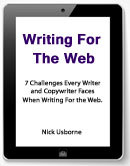Nick Usborne's Blog, page 15
January 9, 2017
3 Ways to attract quality inbound links to your website or blog.

When it comes to attracting more traffic to your blog or website, everyone is all over search engine optimization, content marketing and social media.
These are the hot tickets.
Optimize for the search engines!
Spend more on content marketing!
Go viral through social media channels!
There’s nothing wrong with focusing on these three areas. They are all important.
But that doesn’t mean you should forget one other area of activity that is just as valuable to online marketers.
Link building.
Link building means attracting inbound links to your site from other relevant and high-value sites.
When you’re looking at your analytics page, this inbound traffic is called “Referral” traffic.
Inbound links are also referred to as backlinks.
This is high-value traffic. It’s the online version of word-of-mouth. By placing a link to your site, people and companies are saying, in , “Check these guys out. We like and trust them. You should too.”
In fact, referral traffic has a very special place in Google’s heart too.
Google uses inbound links as a way to determine the relevance and value of the pages and posts you create. The more inbound links you get from other relevant and high-value websites, the bigger the thumbs-up you’ll get from Google.
Recently Google identified – for the first time – the two factors they pay most attention to when ranking your page.
These two things are the quality of the content you create and the volume and quality of the inbound links that point to your site and its pages.
So there are powerful reasons why you should be creating quality content that is specifically optimized to attract inbound links.
What kinds of content are most likely to attract the most links? Here are three types of content that can help.
1. Create a definitive guide
This is when you create an evergreen content page. Build a long-form page that becomes the definitive source of information on a topic that is important to your audience.
You can create guides like this on any topic that is relevant to your business.
As an example, check out the guide to the Google Panda Update, published and updated periodically by the folks at SearchEngineLand.com.
It attracts a ton of inbound links simply because it is such a useful source of information on a topic that is incredibly important to online marketers.
2. Answer a much-asked question
Identify a question that is asked frequently by people who come to your site, and you’ll have a topic for a new post or page that could attract a ton of inbound links.
Here is an example on one of my own websites, CoffeeDetective.com. A reader asked a question about whether or not the plastic used in making Keurig K-Cups is safe or not. And I provided an answer. More important still, I opened up a comment stream on the page.
The page is now very long… comprising my own answer to the question, plus a ton of comments from my readers.
At some point, the page became long enough, interesting enough and useful enough to start attracting a large number of inbound links.
3. Create something exceptionally interesting or useful
This is easier said than done, of course. But always worth aiming for.
A great example of what I mean is the essay by Kevin Kelly on “1,000 True Fans”.
This page is almost iconic in its fame. Yes, it helped that Kevin Kelly already had a strong public profile when he wrote the piece. But the essay still stands on its own merits.
Haven’t read it before? Bookmark it now and read it later.
This speaks to the whole debate over quality over quantity. While you need to create content with reasonable frequency, it will always make sense to occasionally put aside the time to produce something that at least has a chance of becoming an inbound-link magnet for your website and business.
Wrapping it all up…
People don’t talk about inbound links enough. Nor do they put enough effort into creating content that is optimized to attract inbound links.
This means you have an opportunity in front of you right now. Do what other people aren’t doing. Become an inbound link freak.
For more on optimizing for inbound links… and for SEO, social media and content marketing… check out my course, Web Content Optimization.
The course is one of my quick-win, short-form courses, available through the Udemy platform. Use this link to get Web Content Optimization and you’ll enjoy a big, fat discount.

If you found this post helpful, sign up for my e-newsletter and get a free copy of my 35-page guide…
Writing For The Web #1 — 7 Challenges every Writer and Copywriter faces when writing for the Web.
Sign up and I’ll send you the link for the download, and then you’ll receive my most recent post as part of my e-newsletter every Tuesday morning.
Sign Up for my Excess Voice Newsletter…
Name:
Email:
0 subscribers
We respect your privacy
Email Marketing by GetResponse
(Your email address will be used only for the purpose of sending you this newsletter, and you’ll be free to unsubscribe at any time.)
The post 3 Ways to attract quality inbound links to your website or blog. appeared first on Writing for the web - online copywriting and content writing..
December 30, 2016
If you can’t find a story to tell… borrow, steal or create one.

A while back I wrote a post about how selling is giving way to storytelling.
The thing is, “selling at people” just isn’t a good fit online. Nobody wants to be interrupted and sold at when they’re looking at their tablet or smartphone. That’s why tens of millions of people use adblockers.
Soo… if the traditional, hard-nosed sales approach is no longer welcome, what can marketers do?
First off, they can get serious about content marketing.
The delivery of great content, across all devices, will do about 80% of the heavy lifting when it comes to getting prospects ready to make a purchase.
Just because people don’t want to be exposed to hard-hitting sales pitches doesn’t mean they’re not interested in reading or viewing great content related to your products or services. They are.
As for bridging that last 20%… first, use the power of story and then, by all means, include a short sales pitch.
If you’ve delivered great content and shared an engaging story, people won’t mind at all if you respectfully reach out to close the sale.
But what if my business or my client doesn’t have a story to tell?
I hear this all the time.
“We don’t have any interesting stories to share.”
“We don’t have a compelling origin story. The origins of our business were pretty mundane.”
“We don’t have a ‘hero’s journey’ story to share. Just a team of engineers moving forward step by step.”
If you have a client who claims their business has no story, there are three things you can do.
First, challenge them.
Put on your “story hunter” hat and dig into their business and its origins. Think and work like an investigative reporter.
This usually means looking for “sources” within the company. Just because the marketing folks you’re dealing with don’t know any stories doesn’t mean there aren’t any to be found.
See if you can get to talk to the people who have worked there the longest. These may not even be the most senior people.
And the stories you are looking for don’t have to be huge and world-changing. It could be a simple, human interest story. Like the day they delivered their product through a snowstorm and saved the day for some family, sports team or small business.
Dig deep enough and you’ll always find some stories.
The second thing you can do is leverage or piggyback other people’s stories.
Think about Red Bull. They sell an energy drink. Doesn’t taste very good. It may or may not work as advertised. But they have created a huge and successful business.
And they did it with story
They don’t really have a story of their own. So they set out to create new stories every day by sponsoring extreme sports. Their marketing is built on the back of the stories they create with their partnerships and sponsorships.
They are leveraging stories that are actually not their stories at all, but the stories of extreme athletes.
Nespresso – a maker of automatic espresso machines – does something similar by using George Clooney as their spokesperson. They are leveraging every cool role he has ever played. They are piggybacking on the success of the stories he has told as an actor.
Third, do something to seed the creation of new stories.
Dove’s Real Beauty Campaign has been running for well over 10 years now. It tells stories of our perceptions of women’s beauty, and has helped a generation of women redefine what it means to feel beautiful.
Nordstrom seeds new stories through “Nordy Stories”. They asked their customer service people to watch out for and collect great customer stories that could the be used in their marketing.
With your own clients, or your own business, simply ask yourself how you can do something new or different. Something that will stimulate discussion and feedback. Something worth talking about and sharing. Something that might catch the media’s attention.
Wrapping it up…
Stories have always been a powerful way to grab and hold people’s attention, and then engage them at a deep emotional level.
The web has put stories on steroids, because the medium gives everyone a voice, and has made the telling and sharing of stories global.
And the arrival of social media and smartphones has further expanded the power of stories.
Stories are the foundation of the new selling.
Deliver great content. Tell great stories. And then, with the lightest of touches, close the sale.
NOTE: If you’d like to use the power of storytelling to increase your skills as a web content writer, online copywriter or social media writer, take my course… Selling With Stories…

If you found this post helpful, sign up for my e-newsletter and get a free copy of my 35-page guide…
Writing For The Web #1 — 7 Challenges every Writer and Copywriter faces when writing for the Web.
Sign up and I’ll send you the link for the download, and then you’ll receive my most recent post as part of my e-newsletter every Tuesday morning.
Sign Up for my Excess Voice Newsletter…
Name:
Email:
0 subscribers
We respect your privacy
Email Marketing by GetResponse
(Your email address will be used only for the purpose of sending you this newsletter, and you’ll be free to unsubscribe at any time.)
The post If you can’t find a story to tell… borrow, steal or create one. appeared first on Writing for the web - online copywriting and content writing..
December 16, 2016
Master the headline, and you master the page.

Any sales copywriter will tell you the headline is the most important element on the page.
If you don’t get the headline right, it doesn’t matter how good the rest of the page is, because nobody will read it.
Copywriters know this. And online content writers need to understand it too.
David Ogilvy, one of the greatest copywriters of the last century, used to say that once you have written the headline you have spent about 80 cents of every dollar your client will spend on that ad.
Put another way… 80% of your visitors read the headline, but only 20% will read the body of the page.
He made his observation about writing ads.
But you can say the same – and do the same math – when you look at the creation of content online.
If your headline fails to grab attention and make people want to keep reading, watching or listening… then that entire piece of content just failed.
This makes content headlines the single greatest point failure for all the content companies create.
Scary thought.
Until you think of the flipside to that.
Headlines are also the greatest single point of opportunity for every page or screen of content.
Imagine if you could get more than just 20% of visitors to keep reading or viewing the content below the headline.
Move the dial a little. To 25% or 30%. More even.
Now do the math and see what that means in terms of additional revenues over the next 12 months.
That number is going to vary from company to company. But for any company that invests seriously in content marketing, even the 5% move from 20% to 25% is going to be a very, very big deal.
And, of course, the content writer who delivers that kind of improvement is going to be a huge hero.
Think about that.
If you write online content, this is a quick win for you.
Just improve your headlines a little, and you get an outsized improvement to the results from every page you create. And an outsized increase in your value to that client and any others you work with.
As I say in the headline to this post… Master the headline, and you master the page.
I can’t think of any other way in which an online writer can increase his or her value so quickly, and in such a clear and measurable way.
Which is why I invested several months in putting together a short-form course that teaches the craft of headline-writing for online content.
The course is called How to Write Better Headlines – For Content, Email and Social Media.
You can learn more about it here…

If you found this post helpful, sign up for my e-newsletter and get a free copy of my 35-page guide…
Writing For The Web #1 — 7 Challenges every Writer and Copywriter faces when writing for the Web.
Sign up and I’ll send you the link for the download, and then you’ll receive my most recent post as part of my e-newsletter every Tuesday morning.
Sign Up for my Excess Voice Newsletter…
Name:
Email:
0 subscribers
We respect your privacy
Email Marketing by GetResponse
(Your email address will be used only for the purpose of sending you this newsletter, and you’ll be free to unsubscribe at any time.)
The post Master the headline, and you master the page. appeared first on Writing for the web - online copywriting and content writing..
December 2, 2016
Start your own business as an excuse to have more fun.

Sounds crazy, right?
Starting a business isn’t meant to be about having fun.
It’s meant to be about hard work, late nights and freaking out over your bank balance. Maybe throw in an ulcer or two along the way.
Traditionally, that’s what starting a business has been all about.
I’ve been there myself as part of a few different start-ups over the years. It’s always been about the big dream. And that dream has usually revolved around a huge pot of money.
To get there involves lots of spreadsheets, tons of hard work, numerous sleepless nights and the prospect of catastrophic failure.
Truth be told, that’s pretty much been the story of starting a new business for the last 100 years. Lots of risk and hard work in search of a big, fat reward.
But does it have to be that way?
I don’t think it does. And nor do a lot of other people.
I was listening to a podcast a while back and the interviewer asked his guest why he and his friends had started a new business selling active-wear clothing.
The reply? I don’t remember the exact words. But it went something like this.
“It’s an excuse to get out there and have fun doing what we enjoy most!”
These guys sell their active-wear by shooting videos of themselves outdoors doing extreme stuff on mountain bikes, snowboards, skidoos and so on.
Instead of pouring over spreadsheets, these guys were thinking, “Hmm… we like going outside and doing crazy stuff. What kind of business can we launch that would involve us in doing more of that fun stuff?”
First they looked at the fun things in their lives, and then they built a business around that.
And those guys aren’t alone…
As I thought about it, I realized I’m doing something similar when I work on my website about coffee, CoffeeDetective.com.
I didn’t start writing it thinking, “Hmmm, if I invest X amount of money and Y number of hours, I’ll make Z dollars in income over the first three years.”
I began writing the Coffee Detective site because I love coffee. Today, 10 years later, I feel the same way about both coffee and my website.
I am still writing, taking photos and shooting videos because I’m really interested in coffee.
Does the site make me a nice second income? Yes it does.
Am I blind to the financial aspect of the site when I create new pages? Of course not. Every time I upload a new page, I make sure there are ads and other money-making links on the page.
But the primary driver behind the site is still my passion for coffee.
The money comes BECAUSE I’m passionate about coffee.
For as long as I still feel that way, and still have fun adding new content to the site… then the money will keep flowing.
I love this way of thinking about business.
I love that the starting point of a money-making business can be passion and fun… and not spreadsheets and revenue projections.
Will my Coffee Detective website ever become my primary source of income? I have no idea.
For now it’s enough that I can have fun doing something I’m passionate about… and make a solid second stream of income at the same time.
NOTE: If you have a topic you’re passionate about, and would like to write about, check out my course… How to Write Your Own Money-making Websites.

If you found this post helpful, sign up for my e-newsletter and get a free copy of my 35-page guide…
Writing For The Web #1 — 7 Challenges every Writer and Copywriter faces when writing for the Web.
Sign up and I’ll send you the link for the download, and then you’ll receive my most recent post as part of my e-newsletter every Tuesday morning.
Sign Up for my Excess Voice Newsletter…
Name:
Email:
0 subscribers
We respect your privacy
Email Marketing by GetResponse
(Your email address will be used only for the purpose of sending you this newsletter, and you’ll be free to unsubscribe at any time.)
The post Start your own business as an excuse to have more fun. appeared first on Writing for the web - online copywriting and content writing..
November 24, 2016
Online, you’re often writing headlines even when you’re not.

I know, today’s headline is a bit of a brain-twister.
Here’s what I mean…
There are places online where we write headlines, and are fully aware that we’re writing headlines.
Examples include the headline you might write for a website’s homepage. Or at the top of a blog post. Or on a review page. Or on a sales page or landing page.
These are the places we expect to find headlines.
But how about an email subject line? Is that a headline?
Or the line of text you add at the top of that update you just posted to Facebook.
Or the title tag you just wrote for that new web page or post.
Or the title you wrote for the video you uploaded to YouTube.
Are those all headlines?
I think so. I think they are all headlines.
They are all about the same length, and they are all trying to do the same thing.
Hmmm… what exactly ARE headlines meant to do?
Traditional headlines have a couple of duties to perform.
First, they need to grab your attention and make you read them.
Second, they have to make you want to read, watch or otherwise consume the content immediately following the headline.
That’s it. That’s all.
So yes, an email subject line is definitely a headline. It sits there among a screen of competing subject lines in the recipient’s inbox.
It had better be compelling enough to attract attention. And it has better be interesting enough to make you want to click and open that email.
The title for your latest YouTube video is also a headline.
It’s going to appear in search results, competing for attention. And it’s going to appear along with a thumbnail of the video itself on listings within YouTube.
The same goes for your next Tweet, or the description you write when you upload a photo to Instagram.
These are all headlines.
The thing is, very few online writers TREAT them as headlines.
By that I mean writers generally spend very little time writing the title to a YouTube video compared to the time they spend writing a headline for their latest blog post or sales page.
We all understand that headlines are important.
So when we recognize something as a headline, we pay attention and give the task the time it deserves.
The problem is that very often we fail to identify a piece of short-form text as actually being a headline. So we rush it.
As always, there is both a problem and an opportunity here.
The problem is that many subject lines, video titles and social media descriptions are hurried. Their importance isn’t recognized. And those lines under-perform.
The opportunity is that when you master the craft of writing ALL kinds of online headlines, you give yourself or your clients an outsized advantage.
Headlines matter. A lot.
This is why I’m currently working like crazy to complete a short course on how to write better headlines for web content, email and social media.
If you want to be among the first to hear when it launches, just sign up for my e-newsletter below.

If you found this post helpful, sign up for my e-newsletter and get a free copy of my 35-page guide…
Writing For The Web #1 — 7 Challenges every Writer and Copywriter faces when writing for the Web.
Sign up and I’ll send you the link for the download, and then you’ll receive my most recent post as part of my e-newsletter every Tuesday morning.
Sign Up for my Excess Voice Newsletter…
Name:
Email:
0 subscribers
We respect your privacy
Email Marketing by GetResponse
(Your email address will be used only for the purpose of sending you this newsletter, and you’ll be free to unsubscribe at any time.)
The post Online, you’re often writing headlines even when you’re not. appeared first on Writing for the web - online copywriting and content writing..
November 21, 2016
If you want people to remember something, tell them a story.

A few months back I wrote about how telling stories can influence people’s feelings.
In fact, writers of all stripes have been using stories to tap into people’s emotions for centuries.
Well… it turns out that as well as evoking strong emotions, stories are also a powerful tool to help us remember things.
A few days ago I was listening to the Tim Ferriss Show podcast. His guest was Stephen Dubner, one of the authors of Freakonomics.
In response to a question about the power of stories, Stephen came up with some interesting numbers.
Which book, he asked, is the most famous and widely read globally? Probably the bible. Anyway, the bible is certainly the most widely read book in the United States.
However, he said, only 17% of Americans can recite the Ten Commandments. A much higher proportion can name all the characters in the Brady Bunch TV show.
It’s not that Americans have terrible memories, or that they’re not devout enough. Or that they feel the Ten Commandments are unimportant.
The problem is that lists are by their very nature boring and hard to remember.
However, find someone who is not a devout Christian, but who sat in class and listened to bible stories while they were at school several decades ago, and you see a very different picture.
Everyone remembers bible stories.
Adam and Eve. David and Goliath. Jonah and the Whale. Daniel in the Lion’s Den. Noah’s Ark. The Nativity.
In fact, people remember all kinds of stories.
You don’t have to be a classical scholar to have heard of Hercules, Achilles, Odysseus and other heroes of Greek Mythology.
Nor do you have to be a student of Shakespeare to know the stories of Hamlet or Romeo and Juliet.
The thing is, stories have a way or burrowing into our memories and staying there.
If you find all this a little self-evident, go back through your own copywriting or content writing work and look for 1) Lists and 2) Stories.
Quite a few lists, right? And yes, a series of indented bullet points counts as a list. A post or article with a headline that has a numeral at the beginning is a list. Like… 10 Ways to rock your readers with lists!
If you’re just after clicks on ads, lists are OK. Nobody cares if readers remember those posts or not.
But if you are trying to connect with your audience.
If you want them to remember you.
If you want them to remember your message, products and services.
Well… lists won’t serve you very well.
Ask Moses. He delivered the most famous list of all time, and people still can’t remember it.
But people can remember 10 ways in which Wile E. Coyote tried to kill the Road Runner. Why? Because that list was embedded in a series of stories.
Next time you’re writing copy or content and find yourself writing a list, pause and think for a moment.
First, keep in mind that nobody will remember your list.
Second, ask yourself if there is a way to embed that list in a story.
Make it part of a story and you’ll end up creating something a lot more powerful and memorable.
NOTE: If you’d like to use the power of storytelling to increase your skills as a web content writer, online copywriter or social media writer, take my course… Selling With Stories…

If you found this post helpful, sign up for my e-newsletter and get a free copy of my 35-page guide…
Writing For The Web #1 — 7 Challenges every Writer and Copywriter faces when writing for the Web.
Sign up and I’ll send you the link for the download, and then you’ll receive my most recent post as part of my e-newsletter every Tuesday morning.
Sign Up for my Excess Voice Newsletter…
Name:
Email:
0 subscribers
We respect your privacy
Email Marketing by GetResponse
(Your email address will be used only for the purpose of sending you this newsletter, and you’ll be free to unsubscribe at any time.)
The post If you want people to remember something, tell them a story. appeared first on Writing for the web - online copywriting and content writing..
November 6, 2016
And the secret to writing an open-ended headline is…

If you’re not totally into writing great headlines, you should be.
When you’re writing online, headlines are everywhere.
Actually, anything you write that’s 15 words or less should be treated like a headline.
Headlines for blog posts, articles, reviews, buyers’ guides and even homepages.
For email subject lines. Same for e-newsletters. Headings within those emails and e-newsletters.
Tweets. Titles for Facebook updates. Bios for Instagram.
Whenever you’re short-form writing online, you’ll do well to think “headline”.
And just one of the things to understand about headlines is the difference between those that are closed and those that are open.
Here are examples of each.
First, a version of a headline that is closed…
> Drinking a glass of milk a day is good for you.
It’s just a statement. A claim. I read it and think. “Hmm, OK. Maybe that’s true.”
But do I feel compelled to keep reading? Do I feel a sudden and urgent need to discover why milk might be good for me? No. Because this is a closed headline. It’s self-contained. It included both the question and the answer. Is milk good for me? Yes, it is. There is no reason for me to keep treading.
Now let’s look at a version that is open ended…
> Why your grandmother told you to drink this every day.
This is the open-ended version of a headline for the exact same article or post.
But this time I don’t try to tell the whole story in the headline.
This time I am trying to get you hooked and intrigued.
Heck, I’m even getting you to think about your grandma and whether or not there was anything she told you to drink each day.
Am I being a little manipulative here? Sure I am. But in a totally harmless way. I’m just being playful.
And beyond the playfulness, I’m also doing my job.
Because my job is to write a headline that gets as many people as possible to read the body of the page or screen.
And I can’t get people to keep reading if my headlines are closed. They have to be open-ended. They have to deliver just a teeny part of the answer, or maybe no part of it at all.
Writing open-ended headlines isn’t so hard.
Go to a few of your favorite blogs and news sites. Cut and past 50 headlines into a text document. Read through them and identify which headlines are closed and which are open-ended.
With the closed one, write a new version or two.
Get into the habit.
Make it a good habit, and you’ll soon start writing much better headlines, email subject lines, tweets, Facebook updates and so on.
The web is filled with opportunities to write lines of 15 words or less.
Make the most of them.
NOTE: I have a new course on optimizing digital headlines coming soon. In the meantime, for more on web content creation and optimization, check out my course, Web Content Optimization.

If you found this post helpful, sign up for my e-newsletter and get a free copy of my 35-page guide…
Writing For The Web #1 — 7 Challenges every Writer and Copywriter faces when writing for the Web.
Sign up and I’ll send you the link for the download, and then you’ll receive my most recent post as part of my e-newsletter every Tuesday morning.
Sign Up for my Excess Voice Newsletter…
Name:
Email:
0 subscribers
We respect your privacy
Email Marketing by GetResponse
(Your email address will be used only for the purpose of sending you this newsletter, and you’ll be free to unsubscribe at any time.)
The post And the secret to writing an open-ended headline is… appeared first on Writing for the web - online copywriting and content writing..
October 29, 2016
Tap into the power of a shared, common experience.

If, like me, you write a blog, you’ve probably promised yourself you’ll post at least once a week.
Or maybe twice a week. Daily even.
There are plenty of good reasons for posting to your blog, whether you run a business or work as a freelancer.
Writing a blog makes sure your voice is heard. Writing posts regularly helps get your message out there, and keeps your name on people’s lips. (Google likes to see you posting regularly too.)
Is it always easy to come up with new post ideas? No, it isn’t.
In my case, sometimes l’ll have a lineup of ideas for posts, all clamoring for attention. But other times the well runs a little dry, and I have to cast around for inspiration.
I’m guessing it’s not so very different for you.
OK… let’s pause for a moment. Because that last line encapsulates what I want to talk about today.
I’m guessing it’s not so very different for you.
When I say that, I’m tapping into a shared, common experience.
I was letting you know that we all have this in common, that we’re the same in this regard… that I’m just like you. I also struggle to come up with ideas for posts.
This is a powerful way to connect with your readers.
When you put yourself on a pedestal, or create a kind of “barrier of expertise” between yourself and your readers, it becomes harder to touch them emotionally.
But when you share an experience, and do it with honestly and transparency, you can touch people very deeply, earn their trust, and hold their attention for longer.
Other examples of tapping into a shared, common experience…
Let’s say you are writing sales copy for a wonderful new, totally waterproof backpack for multi-day hikers.
You could write all about the backpack, and its amazing waterproof “technologies”.
Of course, you’d do better to talk less about the features of the backpack, and more about its benefits. Like being able to walk through stormy weather all day, and still look forward to dry clothes once you have set up camp for the night.
Or… take one step further… and tap into a shared, common experience.
Tell the story of one of your own hikes in the rain. Talk about how it felt to walk through the rain and mud all day, only to discover the change of clothes in your backpack was also wet through.
Every multi-day hiker has been there and knows how it feels.
As soon as you talk about it – when you tell that personal story – you’re triggering shared memories.
And now you can ask your readers to imagine how much better that day would have been if their backpack had been totally waterproof.
When you share memories, and an experience, you are reaching deeper into your reader’s minds and hearts than you could ever achieve with traditional sales copy.
Let’s look at another example.
You’re selling project management software to a company. You’re pitching the benefits of how your service enables even remote workers feel fully engaged in each project.
The shared, common experience? You can talk about a project that almost crashed and burned when a remote worker in another time zone didn’t get the notification she needed.
Everyone using project management software has a disaster story or two they can tell you about.
You don’t have a story like that? Ask the client.
Whether it’s about coming up with ideas for blog posts, dreaming of a dry pair of socks while hiking in the rain, or praying for software that automatically keeps everyone notified of critical events… there will always be shared, common experiences you can share.
These experiences and memories are held in our minds as stories.
Which once again brings me back to the power of stories in marketing.
In this case, we are using the power of stories to trigger shared, common experiences.
And that’s how you get people to truly engage with the message you are trying to share.
To repeat what I said earlier, when you share an experience, and do it with honestly and transparency, you can touch people very deeply, earn their trust, and hold their attention for longer.
And, of course, you’ll ultimately make more sales.
NOTE: If you want to know more about the power of telling stories, check out my course, Selling With Stories…

If you found this post helpful, sign up for my e-newsletter and get a free copy of my 35-page guide…
Writing For The Web #1 — 7 Challenges every Writer and Copywriter faces when writing for the Web.
Sign up and I’ll send you the link for the download, and then you’ll receive my most recent post as part of my e-newsletter every Tuesday morning.
Sign Up for my Excess Voice Newsletter…
Name:
Email:
0 subscribers
We respect your privacy
Email Marketing by GetResponse
(Your email address will be used only for the purpose of sending you this newsletter, and you’ll be free to unsubscribe at any time.)
The post Tap into the power of a shared, common experience. appeared first on Writing for the web - online copywriting and content writing..
October 24, 2016
Use inspirational content to drive engagement and sales.

With some product and service categories, we automatically expect marketers to inspire us.
For example, if we are being sold a weight-loss program, we expect to hear inspirational stories about those who have come before us.
We expect to see before and after photos, and to hear about how people’s lives are improved as they shed those extra pounds.
Weight-loss and wellness coaches help us succeed by inspiring us with positive messages and stories.
It’s what we expect.
But we can also create inspirational content for slightly less obvious categories.
For example, if I am selling you on a destination for your next vacation, I should look for ways to use inspirational content.
Let’s say I’m pitching a trip to Manhattan.
I could do the usual thing, like listing the major tourist spots. I could talk about the tours, the shows on Broadway, exhibitions at the major galleries, deals on hotels, and so on.
By doing that I could get people excited, but not really inspired.
To inspire people, you need to offer them not things to see, or things to do… but experiences.
I could tell the story of a couple who came all the way to Manhattan to see a particular exhibition, only to find the gallery was closed. But as they walked away, trying to swallow their disappointment, they glanced down an alleyway and found a hole-in-the-wall gallery that was even better than the one they first planned to visit.
I’ll write about how this is typical of Manhattan. How it’s the unexpected, serendipitous discoveries you make that define your trip.
I’ll tell other stories too. If I write about a restaurant, I’m not going to write about the menu and décor, but about the conversations enjoyed, the new friends made and so on.
You can take this approach with pretty much anything.
If you’re trying to create content for a fairly mundane produce like a mountain bike seat, don’t just talk about the seat or the bike. Talk about an amazing bike ride you had with friends on a particularly challenging trail last weekend.
Discovering that hole-in-the-wall gallery, the friendly restaurant, and the challenging bike trail are all about experiences, rather than products or services.
What I’m doing here is telling stories that are designed to inspire.
And when you inspire your readers, when they feel that glow of positive energy inside, they will stay engaged with your content for longer and are then more likely to buy.
As you will have noticed by now, the gateway to inspirational content is almost always the telling of a story.
Descriptions of products and services on their own are rarely inspirational. Good stories, however, can inspire in ways that dramatically improve conversion rates.
In other words, to create inspirational content, tell great stories.
NOTE: If you want to know more about the power of telling stories, check out my course, Selling With Stories…

If you found this post helpful, sign up for my e-newsletter and get a free copy of my 35-page guide…
Writing For The Web #1 — 7 Challenges every Writer and Copywriter faces when writing for the Web.
Sign up and I’ll send you the link for the download, and then you’ll receive my most recent post as part of my e-newsletter every Tuesday morning.
Sign Up for my Excess Voice Newsletter…
Name:
Email:
0 subscribers
We respect your privacy
Email Marketing by GetResponse
(Your email address will be used only for the purpose of sending you this newsletter, and you’ll be free to unsubscribe at any time.)
The post Use inspirational content to drive engagement and sales. appeared first on Writing for the web - online copywriting and content writing..
October 16, 2016
Listening to your readers and customers is good. Being smug about it isn’t.

Last week I wrote about how I’m putting together a new course on writing headlines for web content, social media and email marketing.
At the end of the post I asked readers to email me with their suggestions on what should be included in the course, and which questions about writing headlines they would like to see answered.
When I extended the invitation, I was thinking maybe I’d pick up on a few points and questions I might have missed. Truth be told, my slide deck was pretty much done and I was almost ready to start recording.
I just wanted to be sure I hadn’t missed anything big or obvious.
In hindsight, I can see I was being a little arrogant. A little smug. I thought I was 99% there. I just wanted people to help me fill in the last 1%.
But it turns out my course wasn’t ready for me to start recording.
People were incredibly generous with their time and suggestions.
And once I looked at all that feedback in aggregate, it became clear to me that I still had a lot of work to do. In fact, I have gone back to the drawing board and am in the process of restructuring the entire course.
The work I have already done isn’t being wasted. But I need to put everything together differently. And there is plenty of new information I need to add.
Sooo… if you were one of the many people who wrote in with your thoughts and suggestions… THANK YOU!
The point is, I nearly blew it.
When you set yourself up as a subject matter expert, it’s all too easy to get a little smug about things.
“Hey, I’m the expert here.”
So when I reached out for input, I suspect I was looking for validation more than anything else. I wanted to look at people’s suggestions, tick the boxes in my mind and think, “Yep, my course has all that covered.”
Like I said. It didn’t work out that way.
My course will be very different and, I think, a whole lot better, because of so many people’s generosity.
For me, this is a big lesson learned. I’ll try not to make the same mistake again.
But, of course, I’m not alone in being a little smug and lacking in humility sometimes.
A lot of companies pay lip service to the idea of listening to their audiences and customers. But most really don’t have their hearts in it.
Listening is hard work. And if what you hear runs counter to your internal strategies and plans… well, who wants to open up that can of trouble?
The point is, listening isn’t an easy thing. And asking questions should never be a ‘cosmetic’ thing – done just to make you look good.
But if you make a real commitment to paying attention to what people say, the benefits to your business can be significant.
Listening is good. Acting on what you hear is even better!
And thanks again to everyone who helped me with my course.

If you found this post helpful, sign up for my e-newsletter and get a free copy of my 35-page guide…
Writing For The Web #1 — 7 Challenges every Writer and Copywriter faces when writing for the Web.
Sign up and I’ll send you the link for the download, and then you’ll receive my most recent post as part of my e-newsletter every Tuesday morning.
Sign Up for my Excess Voice Newsletter…
Name:
Email:
0 subscribers
We respect your privacy
Email Marketing by GetResponse
(Your email address will be used only for the purpose of sending you this newsletter, and you’ll be free to unsubscribe at any time.)
The post Listening to your readers and customers is good. Being smug about it isn’t. appeared first on Writing for the web - online copywriting and content writing..
Nick Usborne's Blog
- Nick Usborne's profile
- 6 followers





